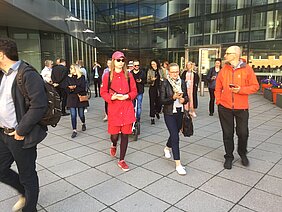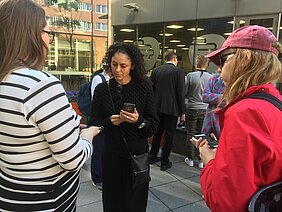Citizens of Helsinki today took part in the first "Ambiciti" walk organised in Finland. The walk was open to all interested in the urban environment and wellbeing and was organized by
EIT Digital, Forum Virium Helsinki and Ambiciti, the first worldwide free collaborative application for noise and air pollution data at a street-level resolution.
Ambiciti, a global environmental data service combines pre-modelled noise and air pollution data with crowdsourced obtained noise data from application users' smartphones. Ambiciti has already been introduced in Paris (France) and the San Francisco Bay Area (USA). The next Helsinki walk is already planned for the autumn.
Valerie Issarny, co-founder of Ambiciti said:
"Ambiciti is the first worldwide free collaborative application for noise and air pollution data at a street-level resolution. It provides the access to the air pollution levels of the users' home street and routes and allows them to plan their routes as to minimize the exposure pollution."
The participants of the first Helsinki Ambiciti walk measured noise pollution with their smartphones during a two kilometres long walk organised in the surroundings of one of the busiest entry routes to the city during the morning rush hour peak. After the walk, measurements were collected, merged to the pre-computed models and pollution exposure during the walk analysed.
How Ambiciti works?
Ambiciti computes the hourly air pollution maps for the current and the four next days. Maps are created by mathematical models that are calibrated with local effective measurements when available. In Helsinki, the base data on air pollution, buildings, and traffic is obtained from the open data provided by the City of Helsinki authorities and amended with additional data from the City Planning Department.
Models include data related to meteorology dynamics and urban morphology such as transports streams regarding time, noise or air emissions and air pollution imported from distant locations to the city. Traffic data is used for noise and air pollution models - residential and industrial data for computing air pollution models. Further, the models integrate physical specificities of areas such as streets and urban canyons, buildings, and compute the propagation of pollutants in the streets.
The street level noise data can be calibrated with data gathered by the Ambiciti mobile application users. The mobile application is available for all devices using Android or iOS operating systems and can be downloaded for free in the respective application stores. The user interface is in English.
Any user of Ambiciti mobile application can choose to share his/her localized noise measurements through space and time. Two modes allow this: a continuous measurement mode and a journey mode (more precise). The sent, user-collected data is integrated with pre-modelled data to provide better maps through time.
The crowdsourced noise data is collected by smartphone microphones. Users must activate the function.
Valerie Issarny explained:
"The application does not record, store or share the actual audio signals. Using the periodic measures of loudness, the application computes sound exposure levels by hour, day and month and allows users to relate noise exposure to their own health and wellbeing."
If authorized by the user in the application's settings, the application will share the computed sound exposure levels to Ambiciti server. Ambiciti then uses measures from multiple users to create maps of noise pollution . No personal data is collected and Ambiciti is not capable to identify user's identity.
For more photos visit our Flickr channel.









